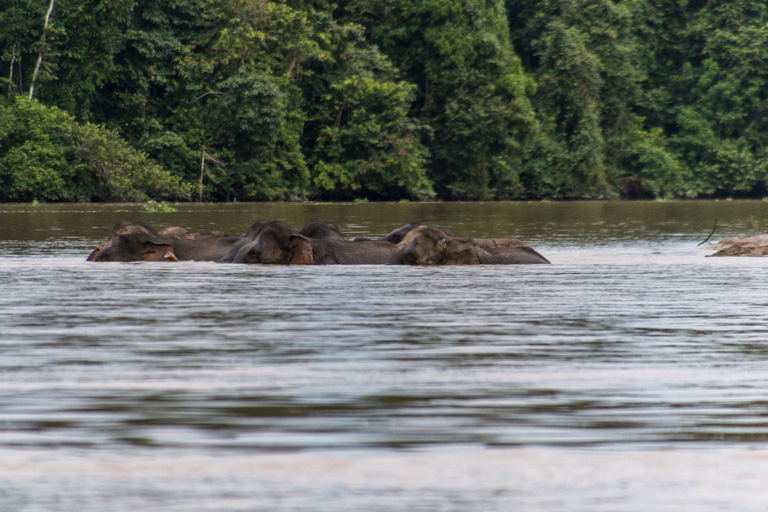- New research has found that Bornean elephants most often use degraded forests with canopy heights topping out at around 13 meters (43 feet).
- Less than 25 percent of the state’s protected intact forests, which include primary forests, are suitable for elephants, the authors concluded.
- The team suggests that maintaining suitable elephant habitat in Malaysian Borneo will require the protection of relatively small patches of degraded forests that elephants favor.
Conservation-minded planners often pick places with the fewest signs of human impact for protection, and, across the tropics, pristine rainforests with the tallest trees often rise to the top of the list.
But safeguarding specific so-called “degraded” areas as conservation targets is also important, especially when they constitute the best habitat for threatened species. A new study supports that conclusion: It confirmed that Bornean elephants (Elephas maximus borneensis), considered by some scientists to be a subspecies of the endangered Asian elephant, actually prefer disturbed forests with shorter trees to denser primary forests.
“There are obviously many benefits of protecting primary forests,” said Luke Evans, an ecologist with the Danau Girang Field Centre in Malaysia and the Carnegie Institution for Science in Stanford, California, and lead author of the paper. “We’re just saying that, for elephants, it’s not particularly useful.”

Evans and his colleagues used a decade’s worth of data on the movements of 29 elephants fitted with GPS tracking collars around the forests of Sabah in Malaysian Borneo. Past research has led scientists to speculate that disturbed forests might be more suitable for elephants than primary forests. In degraded forests, elephants can more easily knock around the smaller trees to get to their foliage, and gaps in the canopy allow light to reach the forest floor, stimulating the growth of understory plants that help sate their big appetites.
For this study, the researchers also incorporated measurements of the height of the forest canopy. In 2016, ecologist Greg Asner, who leads the Carnegie Airborne Observatory (CAO), mapped out the three-dimensional structure of the state’s forests using laser-based lidar technology mounted to an airplane. From the transects, Asner identified some of the tallest trees anywhere in the tropics in Borneo’s primary forests, including one that was 94.1 meters (309 feet) tall.
Evans and Asner, together with wildlife biologist Benoît Goossens, who heads the Danau Girang Field Centre, looked at more than 159,000 data points from the GPS collars. They found that the tagged elephants were hanging out most often in forests where the height of the canopy topped out at around 13 meters (43 feet). In many cases, logging companies have harvested timber from these spots. In other places, they were scrub forests that might never have had sky-scraping trees and high carbon stocks that conservation planners look for.
The animals didn’t visit intact protected forests nearly as much, leading the team to conclude that less than 25 percent of these places are suitable for elephants.
The scientists published their research online March 17 with the journal Biological Conservation.
The importance of forests tagged as degraded to elephants suggests that they’re more valuable than previously thought. However, they’re also often pegged as the most logical choice for new agricultural development. In Sabah, that means that they could become plantations for oil palm, which forms the backbone of the state’s economy.

The team’s research highlights the importance of understanding how species use these areas, Evans said, before they’re converted to industrial agriculture.
Outside of protected areas in Sabah, degraded forests are the bulk of what’s left, Goossens said, leading to questions about which spots should be designated as new protected areas. The Sabah government has set out to protect 30 percent of its land by 2025.
“This paper will help in making decisions in terms of which forests should be selected for conservation,” Goossens said.
The authors also figure that investing in protecting these areas of prime elephant habitat could pay dividends. As a charismatic species, the roughly 2,000 remaining Bornean elephants draw tourists, who contributed $1.72 billion to the economy in 2016, the authors write.
“We found that there were some relatively small areas of forest that were highly, highly suitable,” Evans said. “By targeting those small areas [for conservation], you can increase the overall suitability of the landscape for elephants by quite a bit, with a relatively small amount of additional protected area.”
Banner image of elephants on the Kinabatangan River by John C. Cannon/Mongabay.
Follow John Cannon on Twitter: @johnccannon
CITATION
Evans, L. J., Asner, G. P., & Goossens, B. (2018). Protected area management priorities crucial for the future of Bornean elephants. Biological Conservation.
FEEDBACK: Use this form to send a message to the author of this post. If you want to post a public comment, you can do that at the bottom of the page.
